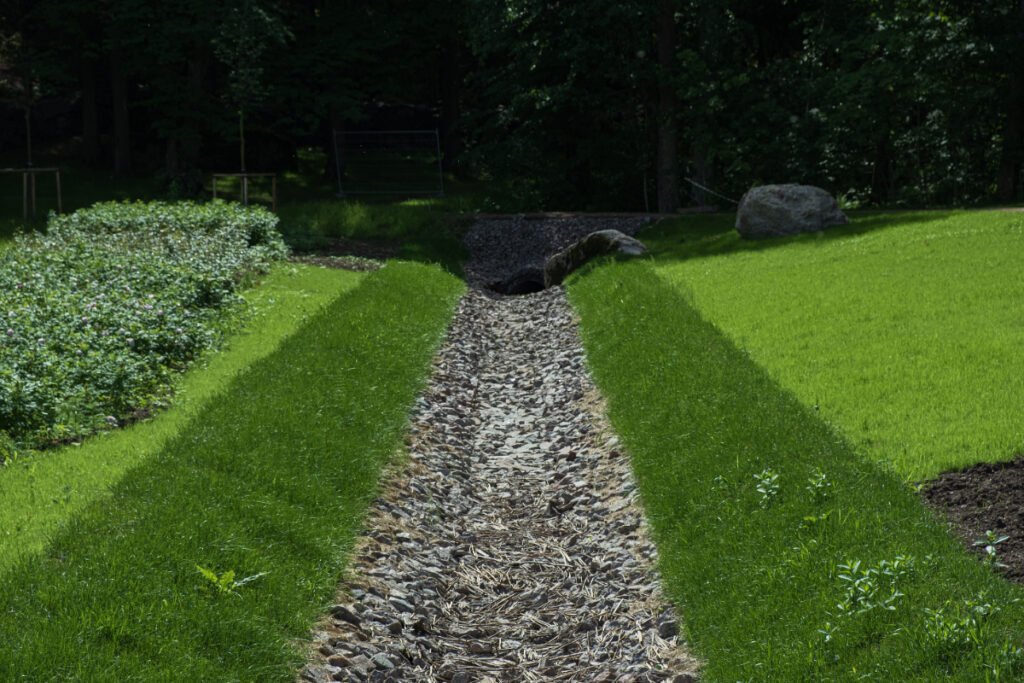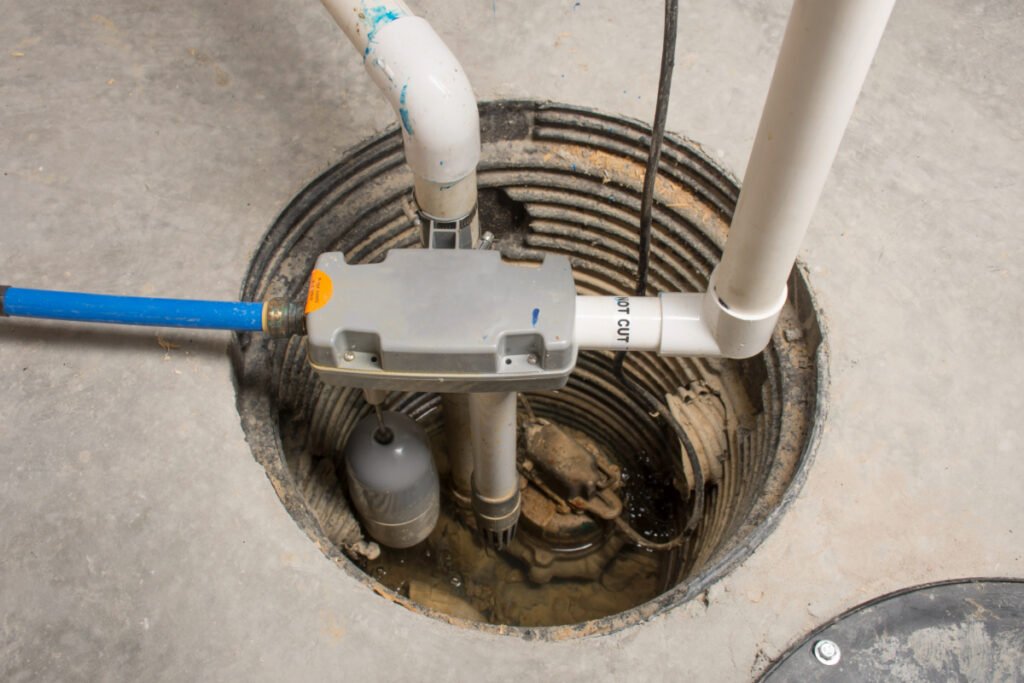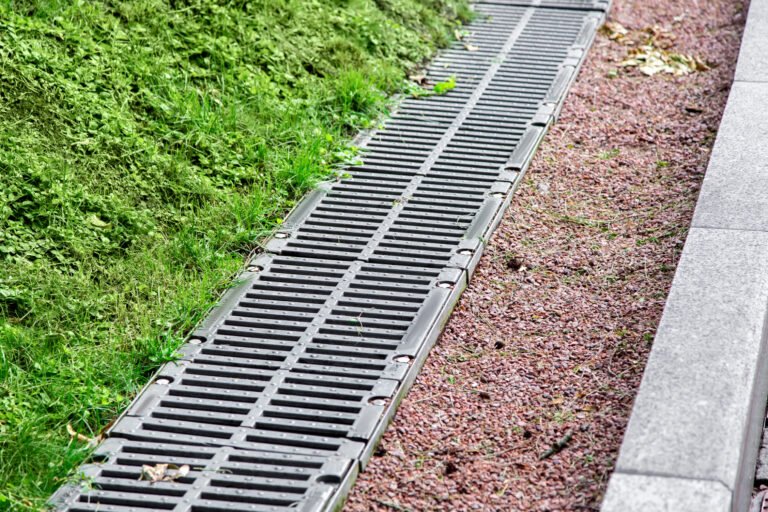French drains are quite a handy tool to eliminate surface water and protect your home from water seepage and flooding. But, since these drains require digging and channeling, they are tedious and backbreaking to install. And, of course, these are pricey and might disrupt your landscape on backflow. So, what’s the solution?
The answer is french drain alternatives. These alternative drainage systems will protect your home’s foundations on a budget. However, these, too, come with various fixtures and yard systems. Thus, it might help to know the pros, cons, and costs to find the best french drain alternative for your home. So, let’s explore more!
Why Should You Consider French Drain Alternatives for Your Home?
While french drain systems can help with direct water percolation and stagnation, they are difficult to install or maintain on heavy slopes, uneven terrain, or marshy areas. Plus, they require much manual work and precise installation from a professional drainage service.
In contrast, a french drain alternative is cheaper, easier to install and maintain, and works with the same efficiency and benefits as listed below.
- Drain pipe and Utility Installation: French drain alternatives don’t interfere with buried electricity, groundwater, and sewer lines and take just a little space on the ground. Thus, you can install all your service lines without any disturbance.
- Anti-clogging technology: Any french drain alternative does not clog or choke, unlike a typical french drain system that might fill up with silt, salts, and sediment and backflow into the house.
- Ease of Installation: These alternatives are extremely easy to install and don’t require precise digging, slopes, or retaining walls to direct the water flow away from the house. Instead, they have a flexible drain tile and catch basin that drains water from different terrains.
- Budget: The french drain alternatives are much more affordable and start at $1,000 to 2000, depending on the size and shape. Plus, they last longer and do not incur high maintenance costs.
- Battery-power: Most alternatives work on a battery-driven motor or sump pump and don’t malfunction with electrical outages.
A List of Common French Drain Alternatives for Better Drainage
French drain alternatives have different trenches, catch basins, and pipes to solve your drainage problem. They even explore materials like crushed stone, gravel, and concrete for adequate water drainage.
So, we explored all the traditional methods, compiled them, and listed their pros and cons to help you.
1. A Swale or Valley

What Is It: A swale or valley is a natural, pipeless shallow trench along the boundary that catches the excess water, collects it, and redirects it to the surrounding woods or ponds just like a canal.
A swale is any natural trench that traps water and drains it to nearby woods or ponds using slopes and gravity. It reduces flooding and can be dug anywhere, depending on the landscape and slope. You can pair this drain with grasses, gravel, or water plants and filter your water before collection.
But don’t forget to add a downward slope and a low-lying trench to collect and direct water properly. And pair shallower swales with gravel, gutters, or ventilated pipes to keep them clean and maintenance-free.
However, swales and valleys are much slower than a typical french drain system and might not drain the excess water on frequent flooding. Plus, they might not be effective if you don’t have any woods or ponds near your house to let off the excess water from your yard.
Best Preferred For: Sloping or Undulated terrain with fewer trees, landscape, and vicinity to natural lakes and woods.
| Average Cost | $200 – 250 or $0.5 per foot for digging |
| Standard Size | 1m X 150mm |
Pros:
- Natural and easy to blend with the existing landscape
- Filters the water and removes pollutants
- Low capital cost and investment
- Doesn’t need pumps, motors, or drainage pipes
Cons:
- Limits the use of trees in landscaping
- Slow, and Inefficient with regular flooding
- Needs woods or ponds nearby
- Might not work in areas with road-side parking
Install a catch basin, cover or downspout to prevent waste and debris from percolating in the swale and polluting the soil or water reservoir nearby.
2. Terracing

What Is It: Terraces are simple concrete or stone steps that move the water downhill and create a beautiful cascading feature, enhancing the landscape and preventing soil erosion simultaneously.
Terraces are large self-draining stairs that direct water to low-lying areas and help prevent puddles. The flat portion of these steps acts as bunds, traps soil, and filters the water naturally.
Moreover, these add a lovely waterfall-like feature to your landscape and are natural and much faster than a typical french drain system. And you can even add some trees and grasses to enhance your landscape and prevent standing water.
However, steps need a sloping terrain and cannot work on flat land. Alternatively, you can install a PVC drainage pipe on the back of each terrace and store water in the rainwater tank for future use.
Best Preferred For: Sloping sites with high surface run-off and a steep terrain.
| Average Cost | $240 per acre |
| Standard Size | 2 – 4 feet in height |
Pros:
- Slows down water speed and reduces runoff
- Filters water naturally and prevents contamination
- Enhances your landscape features
- Prevents soil erosion and surface runoff
Cons:
- Might flood low-lying areas
- Need steep slope or undulated land to work efficiently
- Labour and cost-intensive
- Need a thick retaining wall to prevent mudslides or collapse
Use smaller, 1 – 2 feet steps and add retaining walls for sandy, gravel soils that might slide or break down with continuous water flow.
3. Dry Well

What Is It: A dry well is a narrower and deeper well that catches the heavy drain and percolates it to the adjacent soil, stones, gravel, or underground storage tank.
A tube or dry well is a large hole in the ground that catches water, transfers it to the landscape fabric, and increases the total groundwater level. It is really pricey and requires various drains to function, but it eliminates flooding and is much more efficient than a typical french drain pipe.
However, you must consider that dry wells are susceptible to debris and might clog with time. So, they might need additional excavating for optimal function.
Or, you can simply put a drain cover or curtain drain above the well to prevent dirt from seeping in. Overall, a dry well has fast drainage and stores extra water efficiently.
Best Preferred For: Flat sites, paved landscape areas, or areas with frequent flooding.
| Average Cost | $1500 – 4000, depending on the size |
| Standard Size | 4 – 5 feet in depth |
Pros:
- Quick and efficient drainage
- Reduces flooding
- Recharges groundwater pits and underground tanks
- Excellent for redevelopment or retro-fit areas with limited land
Cons:
- Can fill quickly with excess rains and a non-porous landscaping fabric
- Cost and labor-intensive
- Might fail due to clogging and sediments
- Might leak water in underground cellars or basements
Dry wells should always be at a distance of 10 feet from the house to prevent water from seeping into your home’s foundations and causing a serious drainage issue.
4. Sand Bags

As the name suggests, sandbags are inflatable plastic or plastic-lined cloth bags filled with denser sand and air to redirect the water towards the surface drain and help absorb it efficiently. These are temporary and are used to stop flooding from malfunctioning drains or overflowing ponds.
Additionally, they are affordable and readily available and can be used on flat or sloping terrains. However, these are cumbersome to lift, place, and remove and might absorb water and swell if used for long. Plus, they look baggy and coarse and might disrupt your landscape visuals.
Best Preferred For: Flat or sloping sites with frequent flooding during monsoons.
| Average Cost | $50 – 60 each |
| Standard Size | 18 X 30 inches |
Pros:
- Easy to shift and customizable
- Common and readily available
- Compact and Easy to store
- Quick and Free installation
Cons:
- Labor-intensive and heavy to lift
- Might absorb water and swell
- Temporary and unaesthetic
- Needs an additional drainage system to prevent flooding
Never use porous polyethylene or jute bags as they might absorb water and won’t direct it to the main drainage pipe.
5. Bog Gardens

What Are These: Bog gardens are waterlogged parks with moisture-loving plants, trees, and coarse, self-draining gravel that prevents stagnation and marshes.
Bog gardens catch water in the low-lying areas of any sloping or flat site, filter it and then reuse it to grow plants and trees. These have taller grasses and flowers like Daylily, Bug bane, and Monkeyflower that break the soil, percolate water, and improve the overall drainage system.
Thus, these gardens beautify your landscape and help channel water efficiently. These may have a typical trench drain, channel drain, or dry creek bed to prevent flooding and drain all the excess water from the surroundings. And these are pretty flexible and can be customized to suit your property effortlessly.
Best Preferred For: Larger plots and sites with low-lying, flooded areas and vegetation.
| Average Cost | $1000 – 5000 each |
| Standard Size | Flexible, depends on the site |
Pros:
- Versatile and easily customizable
- Natural water channelization and drainage system
- Enhances the natural landscape of your site
Cons:
- Prone to mosquito and pest breeding
- Need a careful selection of plants and trees for soggy conditions
- Time-consuming to install and plant
- Expensive
Bog gardens are susceptible to heavy mosquito breeding. So, don’t forget to add insect-repellent grasses like lavender, basil, or lemongrass to eliminate those annoying pests.
6. Trench Drains

What Are These: Trench drains are elongated concrete, or metal surface drains with a separate drainage pipe and a grate that catches all the excess water and drains it to the central wastewater line or underground storage tank.
Trench drains are simple grates with a perforated pipe or a weeping tile that directs water to the main drain pipe away from your home’s foundation. These prevent waterlogging in paved areas and parking spaces and have faster drainage with a higher flow rate and retention capacity than a regular french drain.
Trench drains are primarily installed near exterior walls and decks but can be mounted on basement floors and ramps below ground level. And since they already have a meshed drain cover, they don’t require additional water treatment plants and filters. But, they are prone to clogging and leaks and require periodic maintenance.
Best Preferred For: Exterior wall, basement, or crawl space drains on any sloping or flat sire.
| Average Cost | $20 – 30 per linear foot |
| Standard Size | 24, 36, and 48-inch widths |
Pros:
- These do not expand or contract with temperature fluctuations
- Sturdy and long-lasting
- Available in a variety of materials and finishes
- Extremely affordable and no maintenance costs
Cons:
- Machine and labor-intensive installation
- Cannot be modified or expanded, once installed
- Prone to clogging and overflow
Pick sturdier steel, or cast iron trench drains for more strength and weight control on sloping terrains while choosing lightweight polyethylene or concrete grates for flat land.
7. Sump Pump

What Is It: A sump pump is a type of perimeter drain at the lowest point of your house that pumps and diverts the water away from your building foundations and basement, thus reducing flooding efficiently.
Sump pumps are motor or electrically operated pumps that divert water from low-lying areas and prevent overflowing basements or heavy foundation repair. These pumps are affordable and come with a self-activating mechanism that detects flooding and operates the pump.
Moreover, these are more efficient, have higher pumping than typical french drains, and can even be used for uphill drainages. Plus, they have an easier installation that lasts about 10 – 15 years before replacement.
However, these pumps need frequent maintenance and might hike your energy costs.
Best Preferred For: Basement and Cellar drainage or flooding.
| Average Cost | $200 – 350 |
| Standard Wattage | ⅓ or ½ horse power |
Pros:
- Affordable and Easy to install
- Automatic and self-activating
- Increases the home resale value
- Higher warranty
Cons:
- Needs heavy maintenance and repairs
- Works on electricity or diesel motors
- Can be very unaesthetic and visually distracting
- Causes a lot of noise and vibrations
Deep clean your sump pump with a garden hose, scrapper or putty knife and vacuum it once a year to prevent corrosion and rusting.
What Is Better – Sump Pump or French Drain?
Both sump pumps and french drains have their pros and cons but work to eliminate flooding from flat and sloping sites. And while french drains are naturally operated and long-lasting, sump pumps are much faster and sturdier. So, let’s analyze their differences and help you pick the best one for your home.
| French Drain | Sump Pump |
| Manually operated and works for light to medium flooding | Self-activating and works for large quantities of water |
| Work on gravity and can direct water to low-lying areas | Mechanically operated and can direct water to both up-hill and down-hill areas |
| Any exterior or interior french drain installation is labor and time intensive | Easy and Quick installation |
| Doesn’t need any external source or motor | Works on electricity or diesel |
| No mechanical parts and no breakage | Lot of moving metal parts that cause friction and break |
| Natural and noise-free | Extremely noisy and vibrating |
Comparing Popular French Drain Alternatives
| Parameter | Swale | Terraces | Dry Well | Sand Bags | Bog Gardens | Trench Drain | Sump Pump |
| Cost | Low | Low | Expensive | Low | Expensive | Low | Moderate |
| Location | Perimeter | Top Slope | Site Corner | Flooded Areas | Low-lying zones | Exterior Walls | Basement |
| Method Of Operation | Gravity | Gravity | Catch basin | Diversion | Channels | Gravity | Mechanical Plumbing |
| Ease of Installation | Moderate | Moderate | Moderate | Easy | Moderate | Moderate | Easy |
| Speed Of Drain | Slow | Moderate | Fast | Slow | Slow | Fast | Fast |
| Terrain | Sloping | Sloping | Flat | Mixed | Flat | Mixed | Mixed |
| Material | Soil | Concrete | Stone | Sand | Soil | Concrete | Metal |
How to Pick the Best French Drain Alternative?
- Choose gravity-operated trench drains or bog gardens for low to medium flooding areas, but pick machine-operated sump pumps to ease out operations in heavily flooded areas.
- Swales and terraces work the best for sloping sites, while dry wells, pumps, and bog gardens are convenient for flat terrain.
- Install terraces, swales, or bog gardens for efficient drainage with great landscaping features.
Do Downspout Extensions Work?
Yes, downspout extensions or catch basins catch water from your house’s main gutters and push it to the central drain, away from the foundation. Hence, you can use them with swales or trench drains for greater efficiency.
Is a Swale Better Than a French Drain?
Swales certainly have lesser drainage speeds and water retention capacity than most french drains, but do not disrupt your landscape design and cover all the areas of your yard. Generally, swales are great for sloping, low-flooding areas. In contrast, french drains are convenient for flat, urban yards.
When Should You Not Use French Drains?
French drains should be used with water-retaining clayey or loamy soils that might fill the drain pipe and damage your foundation. Similarly, you should not use french drains for uphill drainage or planar lands with no natural slope.
French drain systems are indeed natural and efficient but are pretty slow and don’t work in areas of frequent flooding. On the other hand, different french drain alternatives are fast, durable, and pump water in both uphill and downhill positions as per the site conditions.
Moreover, these are flexible and can go with gravel, crushed stone, and grass to enhance your landscape visuals. So, all you need to do is select an alternative from our list, check its specifications, install it, and you are all set for a puddle-free garden!









